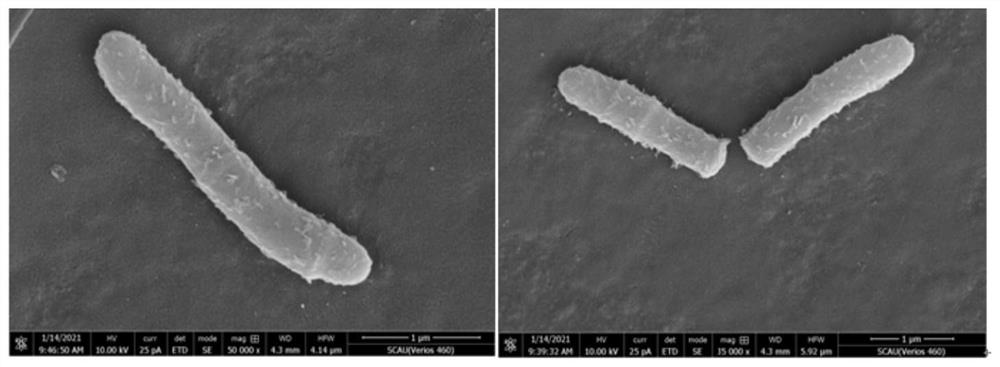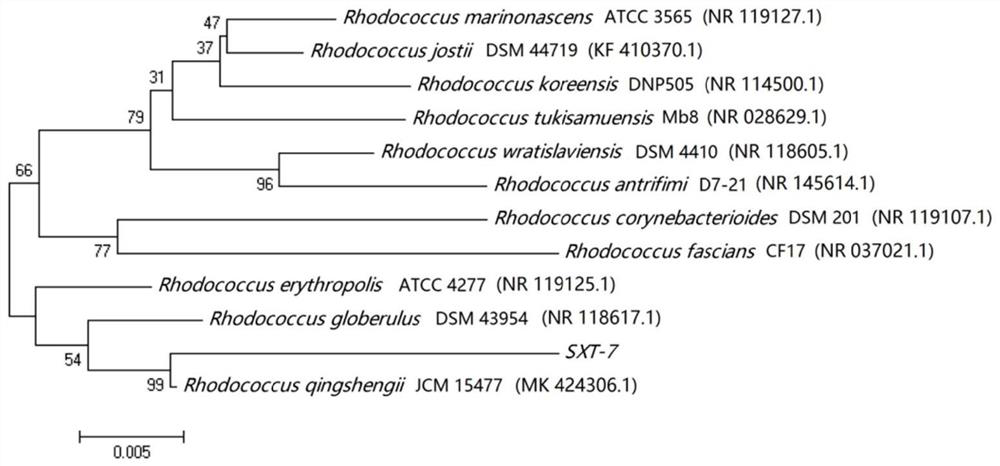AHLs quenching bacterium and application thereof in control of pathogenic bacteria depending on AHLs
A technology of pathogenic bacteria and strains, applied in the application field of pathogenic bacteria, can solve problems such as microbial degradation, achieve good degradation activity, stable degradation effect, and solve the effects of pesticide or antibiotic abuse and drug resistance
- Summary
- Abstract
- Description
- Claims
- Application Information
AI Technical Summary
Problems solved by technology
Method used
Image
Examples
Embodiment 1
[0048] Isolation and screening of embodiment 1 Rhodococcus bacterial strain SXT-7
[0049] 1. Soil sample collection:
[0050] Several soil samples were collected from the offshore shoals of mangrove forests in Shenzhen. After the samples were retrieved, they were stored in a 4°C freezer for later use.
[0051] 2. Enrichment culture of bacterial strains:
[0052] Soil samples collected from mangrove parks were used as microbial sources, and AHLs were used as the only carbon source to enrich and screen the microorganisms. Put the prepared 50mL basal salt medium (MSM) into a 250mL Erlenmeyer flask and sterilize it at 121°C for 20min. After cooling, add N-(3-oxohexanoyl)-L - Homoserine lactone (3OC6HSL) mother solution (concentration is 100mmol / L, solvent is methanol), so that the final concentration of bacterial quorum sensing signal molecule 3OC6HSL is 5 μmol / L. At the same time, 5 g of microbial source soil samples were added, placed on a shaker at 30°C and 200 r / min for 7 ...
Embodiment 2
[0059] The identification of embodiment 2 Rhodococcus strain SXT-7
[0060] In this example, morphological identification, 16S rDNA phylogenetic analysis, and physiological and biochemical identification were carried out on the quenched bacterium SXT-7, and the strain was identified as Rhodococcus sp. details as follows:
[0061] 1. Morphological characteristics of the colony: The colony of the quenched strain SXT-7 is pale yellow and round in the LB solid plate, the colony is smooth and shiny, with neat edges, and the surface is viscous and translucent. like figure 1 As shown; when growing in LB liquid medium, it was diffuse and turbid, and grew well at 28°C.
[0062] 2. Morphological characteristics of bacteria: such as figure 2 As shown, the bacterial cells are rod-shaped, without flagella, and have mucus on the surface.
[0063] 3. 16S rDNA identification and phylogenetic analysis: Using the genome of strain SXT-7 as a template, PCR amplification was performed using b...
Embodiment 3
[0066] Example 3 Detection of degradation activity of Rhodococcus strain SXT-7 on AHLs signal
[0067] In this example, the reporter strain Agrobacterium tumefaciens CF11 was used to detect the degradation effect of strain SXT-7 on AHLs. The strain SXT-7 was activated with LB solid medium plate, and the plate was placed in an incubator at 28°C for 48 hours. Pick a single colony and inoculate it into liquid LB medium, and culture overnight at 28°C and 200rpm to obtain a bacterial solution. Obtain SXT-7 cells with an OD6oo value of 1.0 and inoculate them into 1 mL of MSM inorganic salt medium. MSM only contains AHLs as the sole carbon source. The concentration of AHLs in the reaction system was 40μmol / L. The reaction mixture is incubated under suitable conditions. Then take the reaction mixture and the bacterial liquid of the reporter strain Agrobacterium tumefaciens CF11 for spotting. At the same time, Bacillus thuringiensis subsp. israelensis B23 known to be capable of que...
PUM
 Login to View More
Login to View More Abstract
Description
Claims
Application Information
 Login to View More
Login to View More - R&D
- Intellectual Property
- Life Sciences
- Materials
- Tech Scout
- Unparalleled Data Quality
- Higher Quality Content
- 60% Fewer Hallucinations
Browse by: Latest US Patents, China's latest patents, Technical Efficacy Thesaurus, Application Domain, Technology Topic, Popular Technical Reports.
© 2025 PatSnap. All rights reserved.Legal|Privacy policy|Modern Slavery Act Transparency Statement|Sitemap|About US| Contact US: help@patsnap.com



